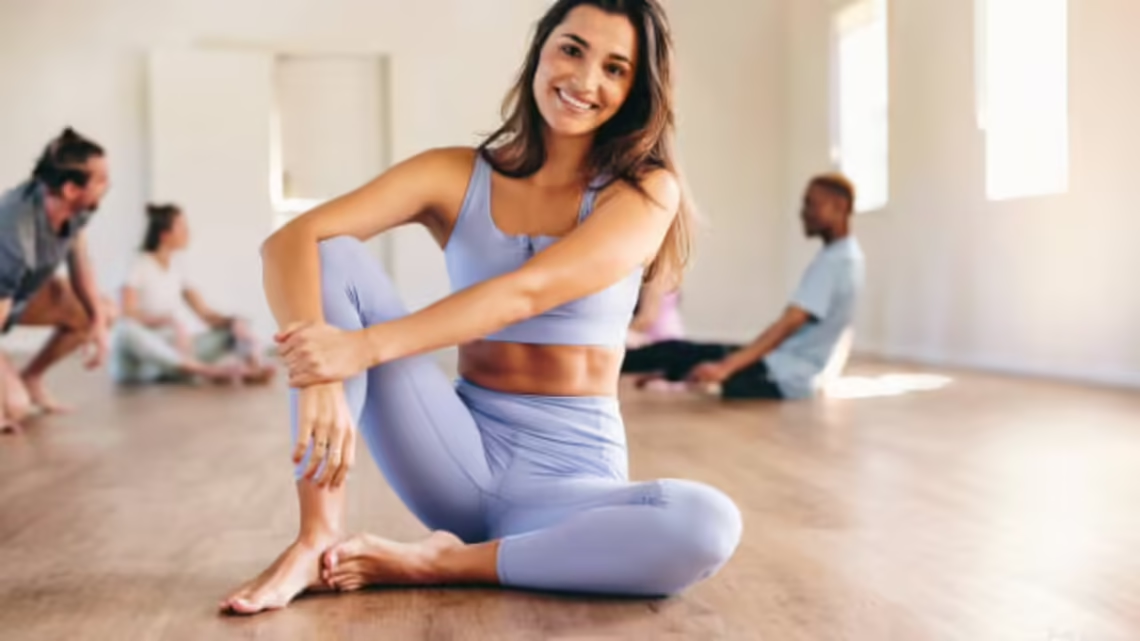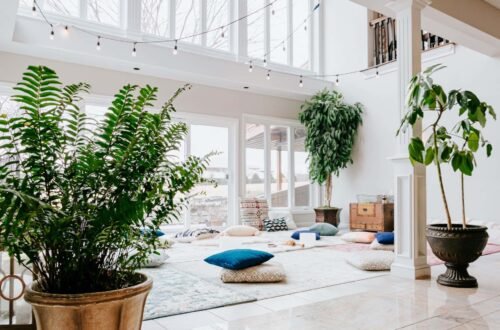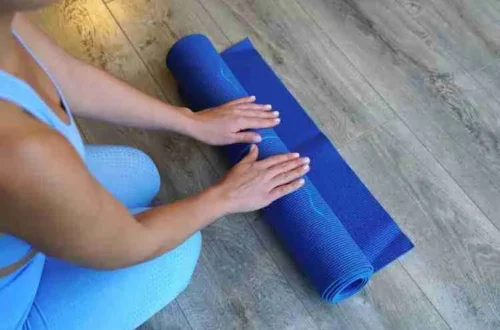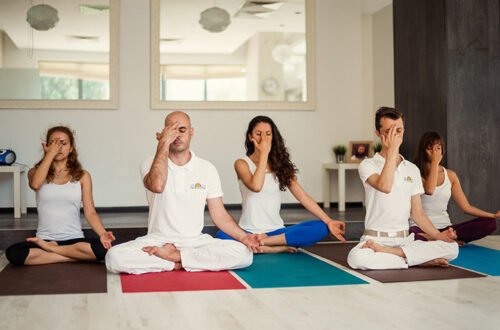Picture this: it’s been a long day, your mind is racing, and your shoulders feel like they’re carrying the weight of the world. I’ve been there, curled up on the couch, overwhelmed by deadlines and life’s chaos. Then I discovered yoga—a gentle, grounding practice that melted my stress away. Yoga isn’t just about stretching; it’s a lifeline for calming both body and mind. In this guide, I’ll share 10 soothing yoga poses, practical tips, and personal stories to help you find peace, whether you’re a beginner or a seasoned yogi. Let’s roll out the mat and breathe through the stress together.
Why Yoga Is a Stress-Busting Superpower
Yoga combines movement, breath, and mindfulness to lower cortisol levels and soothe the nervous system. Studies from places like Harvard Health show it reduces anxiety and improves mood. It’s like hitting the reset button for your soul.
How Yoga Calms the Mind
Yoga activates the parasympathetic nervous system, promoting relaxation. Poses paired with deep breathing slow your heart rate and quiet racing thoughts. I remember my first yoga class—five minutes in, I felt like I’d exhaled a week’s worth of worries.
Benefits for the Body
Beyond mental calm, yoga eases physical tension—think tight shoulders or a stiff neck. It improves flexibility, boosts circulation, and even aids sleep. Regular practice turned my chronic back pain into a distant memory.
Understanding Stress and Its Impact
Stress isn’t just “feeling busy”—it’s a physiological response that can wreak havoc. Chronic stress raises blood pressure, weakens immunity, and fuels anxiety. Yoga counters this by creating a space to reconnect with yourself.
The Science Behind Stress Relief
When stressed, your body releases cortisol, triggering fight-or-flight mode. Yoga’s slow movements and breathwork lower cortisol, as shown in a 2018 study in Frontiers in Immunology. It’s like telling your body, “Hey, it’s safe to chill.”
Why Yoga Works for Everyone
You don’t need to be flexible or fit to start yoga. It’s adaptable for all ages and abilities, from chair yoga for seniors to restorative poses for beginners. Its universal appeal lies in its simplicity—just you, your breath, and a moment of peace.
10 Calming Yoga Poses for Stress Relief
These poses are beginner-friendly, require minimal props, and are designed to melt stress. I’ve included step-by-step instructions, benefits, and personal anecdotes to guide you. Grab a mat (or a soft surface) and let’s get started.
1. Child’s Pose (Balasana)
This gentle forward fold feels like a hug from the earth. Kneel, sit back on your heels, and stretch your arms forward, resting your forehead on the ground. Hold for 1–3 minutes, breathing deeply.
Why It Works
Child’s Pose calms the mind and releases tension in the hips and lower back. The first time I tried it, I felt my worries slip away as I sank into the pose—it’s like a mini-vacation.
2. Cat-Cow Pose (Marjaryasana-Bitilasana)
This flowing sequence warms up the spine. On all fours, alternate between arching your back (cow) and rounding it (cat) with your breath. Do 5–10 rounds slowly.
Why It Works
Cat-Cow syncs movement with breath, easing spinal tension and calming the mind. I use it after long desk hours to shake off stiffness and stress.
3. Forward Fold (Uttanasana)
Stand, hinge at your hips, and let your head hang toward the floor. Bend your knees slightly if needed. Hold for 30–60 seconds, breathing slowly.
Why It Works
Forward Fold releases the hamstrings and back while calming the brain. It helped me during a stressful move—hanging upside down felt oddly liberating.
4. Legs-Up-the-Wall Pose (Viparita Karani)
Lie on your back with your legs resting up a wall. Place a folded blanket under your hips for comfort. Stay for 5–10 minutes, focusing on your breath.
Why It Works
This restorative pose reduces anxiety and improves circulation. I do this before bed to quiet my mind—it’s like a lullaby for my nervous system.
5. Seated Forward Bend (Paschimottanasana)
Sit with legs extended, reach for your feet, and fold forward. Use a strap if you can’t reach. Hold for 1–2 minutes, breathing deeply.
Why It Works
This pose stretches the back and hamstrings, promoting calm. It’s my go-to when I’m overthinking—focusing on my breath feels like pressing pause.
6. Bridge Pose (Setu Bandhasana)
Lie on your back, knees bent, feet hip-width apart. Lift your hips toward the ceiling, holding for 30–60 seconds. Lower slowly.
Why It Works
Bridge Pose opens the chest and reduces tension. I tried it during a tough week, and the gentle backbend felt like it lifted my mood too.
7. Reclined Twist (Supta Matsyendrasana)
Lie on your back, hug one knee to your chest, and guide it across your body to twist. Hold for 1–2 minutes per side, breathing deeply.
Why It Works
This twist detoxifies the body and calms the mind. It’s my favorite after a long day—twisting away stress feels like wringing out a towel.
8. Corpse Pose (Savasana)
Lie flat on your back, arms relaxed, palms up. Close your eyes and breathe naturally for 5–10 minutes. Focus on releasing tension.
Why It Works
Savasana integrates the benefits of your practice, promoting deep relaxation. It’s my ultimate stress-buster, leaving me refreshed every time.
9. Easy Pose with Breathwork (Sukhasana)
Sit cross-legged, hands on knees, and practice deep belly breathing (inhale for 4, exhale for 6). Do this for 2–5 minutes.
Why It Works
This pose with breathwork lowers heart rate and anxiety. I used it during a work crisis, and it felt like anchoring myself in a storm.
10. Standing Mountain Pose (Tadasana)
Stand tall, feet together, arms relaxed. Ground through your feet and lift through your crown. Hold for 1 minute, breathing steadily.
Why It Works
Mountain Pose improves posture and focus, grounding you. I stand in Tadasana before meetings to feel calm and confident.
Comparison: Yoga vs. Other Stress Relief Methods
| Method | Time Commitment | Cost | Accessibility | Physical Benefits |
|---|---|---|---|---|
| Yoga | 10–60 min/day | Low (mat, free videos) | High (home or studio) | Flexibility, strength |
| Meditation | 5–20 min/day | Free–low (apps) | High (anywhere) | Minimal physical |
| Exercise (e.g., Running) | 30–60 min/day | Medium (gear) | Medium (outdoor access) | Cardio, strength |
| Therapy | 1 hr/week | High (sessions) | Low (scheduling) | None directly |
Pros and Cons of Yoga for Stress Relief
Pros: Affordable, adaptable, improves physical and mental health, no equipment needed.
Cons: Requires consistency, learning curve for beginners, not a quick fix.
Where to Practice Yoga
- At Home: Use free platforms like Yoga with Adriene for guided sessions.
- Local Studios: Search for studios via Yoga Alliance for certified instructors.
- Online Classes: Platforms like Glo offer live and on-demand classes.
- Community Centers: Many offer affordable group classes for beginners.
- Parks: Look for outdoor yoga events on sites like Meetup.
Best Tools for Yoga Practice
- Yoga Mat: A non-slip mat like Manduka PRO ensures stability ($100–$130).
- Yoga Blocks: Gaiam cork blocks support poses ($20/pair).
- Strap: A cotton strap like Hugger Mugger aids flexibility ($15).
- Meditation Cushion: Zafu cushions from Barefoot Yoga enhance seated poses ($40).
- App: Apps like Down Dog offer customizable sessions ($60/year).
People Also Ask (PAA)
What yoga poses are best for stress relief?
Child’s Pose, Legs-Up-the-Wall, and Savasana are top choices for calming the mind. Practice them with slow, deep breaths for 5–10 minutes to reduce anxiety.
How often should I do yoga for stress?
Aim for 3–5 sessions per week, even if just 10–20 minutes. Consistency is key—short daily practices can be more effective than infrequent long ones.
Can beginners do yoga for stress relief?
Absolutely! Start with simple poses like Child’s Pose or Easy Pose. Follow beginner-friendly videos or join a local class for guidance.
Does yoga help with anxiety?
Yes, yoga lowers cortisol and promotes mindfulness, reducing anxiety. A 2020 study in Journal of Affective Disorders found regular yoga significantly eased anxiety symptoms.
FAQ Section
How long does it take for yoga to reduce stress?
You may feel calmer after one session, but consistent practice (2–3 weeks) yields lasting benefits. Try 15-minute daily sessions to notice a shift.
What’s the best time to practice yoga for stress relief?
Morning or evening works best. Morning yoga energizes you; evening poses like Legs-Up-the-Wall promote relaxation before bed.
Do I need equipment for yoga?
A yoga mat is helpful, but not essential—you can practice on a soft surface. Blocks and straps are optional for support but enhance comfort.
Can yoga replace therapy for stress?
Yoga complements therapy but isn’t a substitute for professional help. It’s great for managing daily stress but seek a therapist for deeper issues.
How do I stay motivated to practice yoga?
Set a small goal (e.g., 10 minutes daily), join a community, or try fun online classes. Tracking progress or practicing with a friend keeps you engaged.
Tips for a Stress-Free Yoga Practice
- Start Small: Begin with 10-minute sessions to build a habit.
- Create a Calm Space: Use a quiet corner with dim lighting or candles.
- Focus on Breath: Inhale deeply through your nose, exhale slowly to relax.
- Mix It Up: Alternate poses to keep sessions fresh and engaging.
- Be Patient: Progress takes time—celebrate small wins like feeling calmer.
My Yoga Journey
A few years ago, I was juggling a demanding job and family life, feeling like I was always one step from burnout. A friend dragged me to a yoga class, and I was skeptical—could stretching really help? But after my first Child’s Pose, I felt a wave of calm I hadn’t known in months. I started practicing at home, using YouTube videos, and soon yoga became my sanctuary. Poses like Savasana helped me sleep better, while Cat-Cow eased my desk-bound tension. Yoga didn’t erase stress, but it gave me tools to face it with grace. I hope these poses do the same for you.
Conclusion
Yoga is more than a workout—it’s a path to peace for your body and mind. These 10 poses, from Child’s Pose to Mountain Pose, are your toolkit for melting stress away. Start with a mat, a deep breath, and a willingness to try. Explore free resources like Yoga with Adriene or check local studios on Yoga Alliance. Which pose will you try first? Drop a comment—I’d love to hear about your journey to calm!





